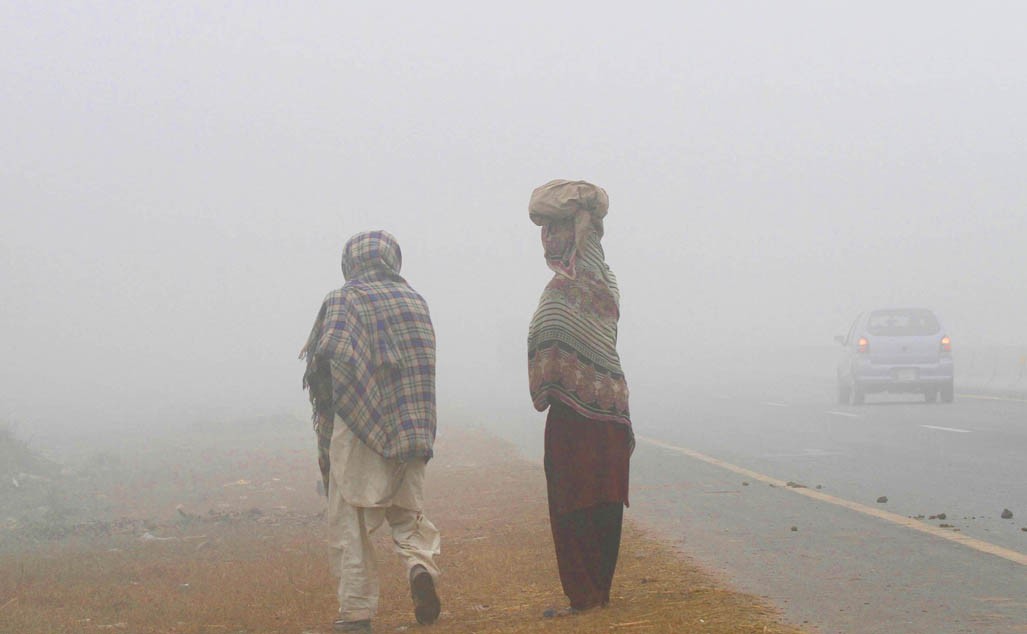
As Delhi takes the first step in following the China Model and implements it, are there lessons in it for the government of Punjab to solve the growing smog issue?

In a cold winter night last week, Nauman Ahmad was driving back home from his office in Lahore. He lives in Muridke, a town not too far from Lahore with industries on both sides of the GT Road. Passing by a large chemical factory he suddenly encountered thick and heavy fog. He had to apply the brakes of his car due to zero visibility. The stretch of road with very poor visibility was about two kilometers long.
He didn’t know that what he thought of as a strange kind of fog wasn’t fog. In fact, it was smog -- a combination of smoke and fog. It is a consequence of visible air pollution in urban and suburban areas.
Smog is caused primarily by a high volume of road traffic, rubbish incineration and uncontrolled industrial emissions. In the winter season, with delayed rainfall, the cold and continuously dry conditions concentrate all the pollutants in the lower levels of the atmosphere, causing the smog to spread all over.
"Carbon emissions in any form cause smog in presence of moisture and drop in temperature between 0 and 6 degrees Celsius" says Dr Ghulam Rasool, Director General (DG) of Pakistan Meteorology Department. "During the process, carbon particles work as condensation nuclei and accumulate moisture over them. They soon get the form of low cloud as they grow fast in ideal conditions.
"Smog is a health hazard. It can cause asthma, lung tissue damage, bronchial infections and heart problems," he explains.
DG Met was of the view that uncontrolled flow of vehicles on roads and violation of environmental laws by the industry are the main reasons behind the increasing smog in cities.
Air pollution is one of Pakistan’s leading environmental concerns at the moment. Karachi, Peshawer, Quetta, Rawlpindi and Lahore have been enlisted among the most polluted cities in the world in different surveys. Main reasons behind this phenomenon are vehicles, brick kilns and industrial emissions combined with rapid urbanisation. The situation is particularly bad in the country’s second largest city. Lahore. The city has been listed amongst the top 10 worst cities for smog, according to a 2014 research of a German institute.
Delhi, however, has taken a step by following the "China Model" to control its own environment problem. For 15 days from January 1, 2016, private cars are only allowed on the city’s roads every other day to reduce pollutant levels. Cars with odd-numbered license plates will be allowed on roads on odd-numbered dates and those with even-numbered plates on the other days.
While talking about Lahore, Director General EPA (Environmental Protection Agency) Punjab, Dr Javed Iqbal, told TNS that the chief minister has constituted a committee to combat the smog issue in Punjab, particularly Lahore. "This high powered committee, chaired by the provincial environment minister, had met once in the last month and the second meeting will be held soon," says Iqbal. "We are taking success stories from other countries into consideration as well. The China Model being adopted in India can be a good step towards the solution."
Transport is considered as one of the main reasons for increasing smog and measures regarding this key sector are necessary for solution of the problem. PAKSTRAN is a project that is giving technical support to the federal, Punjab and Sindh governments for sustainable and environment-friendly transport solutions.
Dr Saleem Janjua, National Manager PAKSTRAN, says the increasing number of private vehicles on roads is one of the main reasons behind the problem and mass transits seem the best solution. "Sustainable transport doesn’t mean only deploying one or two metro lines in the city but an integrated system where feeder routes are also taken into account." Says Janjua. "Increased reliance on public transport and lesser use of private vehicles will definitely provide solution for not only the smog problem but a number of other issues as well. We are also preparing Environmental Quality Standards for transport sector which will be implemented by provincial EPAs."
While admiring the measures taken by Delhi to overcome the smog problem, Federal Secretary Climate Change, Arif Ahmad Khan doesn’t think the issue has reached such a critical juncture in any Pakistani city. "We are working to control carbon emission which is among the main causes of smog. We have taken many steps in the transport sector in this regard."
An SRO has been issued for providing Euro-II compliant fuel and to ensure that a meeting with the Petroleum Ministry is being held onJanuary 14, says Khan. "Motor vehicle industry will be asked to provide Euro-II compliant engines and heat exhaust system in the next step."
Until the measures taken by different departments to reduce emissions come to the implementation stage and people start using more fuel efficient transportation, people are advised to wear masks especially while travelling on the city roads as breathing in these pollutants i.e. dust, sulphur dioxide, nitrogen dioxide and carbon monoxide, is injurious for health.